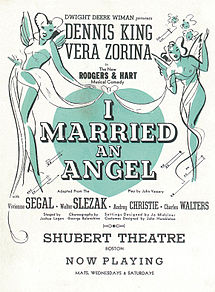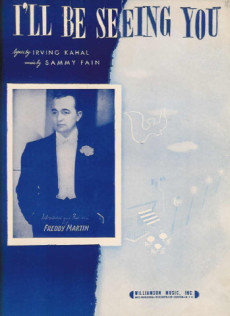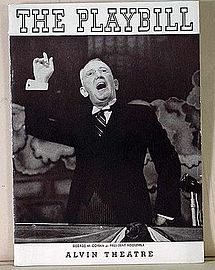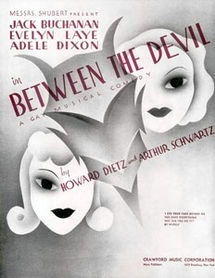
From Broadway To 52nd Street
On October 19, 1938 the musical Knickerbocker Holiday opened at the Ethel Barrymore Theatre starring Walter Huston, Ray Middleton, Richard Kollmer and Jeanne Madden. The play ran for 168 performances with music composed by Kurt Weill and Maxwell Anderson. From the musical came the jazz standard September Song.
The Story: As he is writing the history of New York, Washington Irving seems to wander back to the 17th century just as New Amsterdam is awaiting the arrival of Peter Stuyvesant. The town council seeks to divert the new governor from its corruption and ineptitude by staging a hanging of a rebellious young man named Brom.
Brom has brashly asked for the hand in marriage of Tina, one of the councilor’s daughters. Stuyvesant pardons Brom but refuses him marriage to Tina. Stuyvesant decides to marry Tina, prompting Brom to rouse the citizens against the governor. Sensing the way the political winds are blowing, the governor backs down, his decision aided by Irving’s warning for him to consider his place in history.
Broadway History: While Broadway is experiencing both success and failure, Hitler takes control of the army and marches into Austria; Joe Louis takes the heavyweight championship title from Nathan Mann followed by a first round KO of Max Schmeling; the first play is telecast with the original cast of Susan and God; the Yankee Clipper completes its first cross Atlantic flight; Howard Hughes flies around the world in 91 hours; and instant coffee is invented.
Sponsored By
www.whatissuitetabu.com
More Posts: vocal

From Broadway To 52nd Street
I Married An Angel opened on Broadway at the Shubert Theater on May 11, 1938. Running for three hundred and thirty-eight performances, the musical starred Dennis King, Audrie Christie, Vera Zorina and Vivienne Segal. Richard Rodgers and Lorenz Hart composed the score from which emerged Spring Is Here as another jazz standard.
The Story: The musical tells the story of a banker and ladies man who breaks off his engagement, swearing he will marry an angel. A real angel promptly flies into his life and he marries her. But her angelic honesty causes no end to problems for him until his sister teaches the angel the way of the cynical world. His sister also bribes a cab driver to delay creditors until a way is found to save her brother’s bank.
Jazz History: On the Street of Jazz musicians, jazz lovers, college students and big businessmen—everybody knew that this was “The Street that Never Slept,” the street where every night was New Year’s Eve. Here, for the price of a drink or two, you could walk through the whole history of jazz. Hot jazz was born and raised on The Street, as were the big swing bands of the thirties and the modern “cool” jazz combos of the forties. Comics like Alan King and Joey Adams got their start here, as did musicians like Erroll Garner, Jack Teagarden, and Coleman Hawkins.
Bessie Smith performed on the Street, as did Count Basie, Charlie “Bird” Parker, Dizzy Gillespie, Billie Holiday, Art Tatum, Sarah Vaughn, the Dorsey Brothers, Artie Shaw, and other jazz greats. The Street gave birth in Prohibition-era speakeasies, where musicians jammed for gin or just for the fun of it and its post-Repeal blossoming as the center of the jazz universe. The Street lined up and down on both sides with tiny, smoke-filled rooms where black and white musicians played to capacity crowds long before its postwar decline to become a tawdry tenderloin of strip and clip joints.
Sponsored By
www.whatissuitetabu.com
More Posts: broadway

From Broadway To 52nd Street
Right This Way came to fruition on January 5, 1938 as the production opened at the 46th Street Theatre. Brad Greene and Fabian Storey composed the music with Marianne Brown Waters writing the lyrics for the majority of the musical that was categorized as an original musical comedy set in Paris and Boston. The show starred Henry Arthur, Nelson Barcliff, Christine Bromley and Maude Carroll. Though the show only ran for 15 performances, the one song written by Irving Kahal and Sammy Fain, “I’ll Be Seeing You” was featured and became destined to be a jazz classic.
Broadway History: While Broadway prospered with a variety of shows being produced on The Great White Way not realizing that just some eight months away the city would be struck by what would be labeled as the “Long Island Express” or “The Great New England Hurricane of 1938”. The storm claimed 700 lives, injured another 700 more, destroyed 4500 homes, cottages and farms, damaged another 15,000 along with 26,000 cars, wiping out power above 59th Street, flooding subways and causing the East River to overflow to an estimated tune of three hundred million dollars. Despite the destruction, one unexpected positive outcome did emerge from the storm. The devastation reportedly helped solve the unemployment crisis that had been lingering since the Great Depression, as thousands of people were able to find work on Long Island helping to clean up and repair the damage.
Sponsored By
www.whatissuitetabu.com
More Posts: broadway

From Broadway To 52nd Street
I’d Rather Be Right opened at the Alvin Theatre on November 2, 1937 and ran two hundred and ninety performances. The play starred Joy Hodges, Austin Marshall and George M. Cohen. The composers of the play’s music were Richard Rodgers and Lorenz Hart and one of their songs emerge to become a jazz standard – Have You Met Miss Jones.
The Story: As the story goes, a couple, Phil & Peggy, who wish to marry cannot do so until he receives a raise in pay. This raise was contingent on President Roosevelt balancing the budget. Falling asleep in Central Park, Phil dreams that he and Peggy meet the President. The President, in turn, summons the Cabinet, goes to battle with the Supreme Court, all to help the youngsters. Seemingly stymied, the President then suggests the young lovers marry anyway. When Phil awakens, that’s what they do.
Jazz History: Swing was dance music. It was a “live” broadcast nightly on the radio across America for many years especially by Earl “Fatha” Hines and his Grand Terrace Cafe Orchestra broadcasting coast-to-coast from Chicago. Although it was a collective sound, swing also offered individual musicians a chance to “solo” and “improvise” melodic, thematic solos, which could at times be very complex and “important” music. Over time, social strictures regarding racial segregation began to relax in America: white bandleaders began to recruit black musicians and black bandleaders. In the mid-1930s, Benny Goodman hired pianist Teddy Wilson, vibraphonist Lionel Hampton and guitarist Charlie Christian to join small groups.
More Posts: vocal

From Broadway To 52nd Street
The musical opened in pre-Broadway tryouts in New Haven and Philadelphia in October 1937. Two months later and three days before Christmas on December 22, 1937 Between The Devil opened at the Imperial Theatre. Though it only ran for 93 performances, the play produced by the Shuberts rendered two songs composed by Arthur Schwartz and Howard Dietz that were destined to become jazz standards, By Myself and I See You Face Before Me. The play starred Jack Buchanan, Pierre Antoine, Evelyn Laye, Adele Dixon and Charles Walters.
The Story: The original plot had an English leading man, Peter Anthony, marrying two women at the same time. However, the plot was changed to have Peter Anthony marry the second wife only because he thought his first wife had died.
Broadway History: The Theater Works Project was placed in the hands of Hallie Flanagan, an instructor and creator of an experimental theater at Vassar. She had studied theater in Europe and Russia in the 20s on the first Guggenheim scholarship awarded to a woman, and was fully aware of what Le Gallienne had proposed. Flanagan differed, however, in that she was willing to oversee the development of a national program with chapters throughout the country. New York, with the greatest number of unemployed theater people, would develop six chapters, with other cities developing chapters relative to the number of displaced workers. In an unexpected moment of charity and good will, both George Bernard Shaw and Eugene O’Neill offered rights to their respective works to the Project for the nominal sum of $50.00 per week while they were in production.
More Posts: broadway


